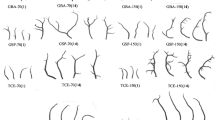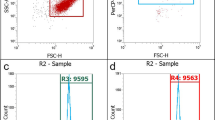Abstract
On the Brazilian coast, the red alga Gracilaria caudata is exploited for agar production. Recently, among the common red wild type (RD), a greenish-brown variant (GB) was collected from a natural population. The aim of this work was to compare the growth (GR), photosynthesis, and pigment content of GB and RD tetrasporophytes cultivated under two irradiances, 70 and 150 μmol photons m−2 s−1, for a period of 28 days. The GB variant is deficient in phycoerythrin, but it produced higher levels of allophycocyanin (APC) and phycocyanin (PC) at 150 μmol photons m−2 s−1. At this irradiance, no difference of phycoerythrin content was observed between strains, suggesting that RD could be using this pigment as a nitrogen source. RD growth rates, irrespective of irradiance, were higher when compared to GB up to 14 days, although no differences were observed in photosynthesis. During the 14-day period, both color strains showed higher GR, maximum electron transport rate, and effective quantum yield at 150 μmol photons m−2 s−1 when compared to 70 μmol photons m−2 s−1. After that, although no differences were observed in the photosynthetic properties, a decrease in GR was seen at both irradiances when RD and GB simultaneously differentiated tetrasporangia. The GB, although fertile, was better able to maintain its growth and even exceed the growth rates of RD in the last week (150 μmol photons m−2 s−1). This characteristic could be advantageous to the species, favoring GB in natural populations, since G. caudata is normally found in the fertile state along the Brazilian coast, and most individuals are tetrasporophytes. This feature could also be important to the selection of this GB strain for future mariculture in Brazil. In addition, their higher concentration of PC and APC could open prospects for a possible use as source of material for pharmaceuticals and fluorescent applications.






Similar content being viewed by others
References
Araujo FO, Ursi S, Plastino EM (2014) Intraspecific variation in Gracilaria caudata (Gracilariales, Rhodophyta): growth, pigment content, and photosynthesis. J Appl Phycol 26:849–858
Ayres-Ostrock LM, Plastino EM (2014) Effects of short-term exposure to ultraviolet-B radiation on photosynthesis and pigment content of red (wild types), greenish-brown, and green strains of Gracilaria birdiae (Gracilariales, Rhodophyta). J Appl Phycol 26:867–879
Bixler HJ, Porse H (2011) A decade of change in the seaweed hydrocolloids industry. J Appl Phycol 23:321–335
Carneiro MAA, Marinho-Soriano E, Plastino EM (2011) Phenology of an agarophyte Gracilaria birdiae Plastino and E.C. Oliveira (Gracilariales, Rhodophyta) in Northeastern Brazil. Rev Bras Farmacogn 21:317–322
Carnicas E, Jiménez C, Niell FX (1999) Effects of changes of irradiance on the pigment composition of Gracilaria tenuistipitata var. liui Zhang et Xia J. Photochem Photobiol B 50:149–158
Costa E, Plastino EM, Petti R, Oliveira EC, Oliveira MC (2012) The Gracilariaceae Germplasm Bank of the University of São Paulo, Brazil—a DNA barcoding approach. J Appl Phycol 24:1643–1653
Costa VL, Plastino EM (2011) Color inheritance and pigment characterization of red (wild-type), green strains of Gracilaria birdiae (Gracilariales, Rhodophyta). J Appl Phycol 23:599–605
De Wreede R, Klinger T (1988) Reproductive strategies in algae. In: Lovett-Doust J, Lovett-Doust L (eds) Plant reproductive ecology: patterns and strategies. Oxford University Press, Oxford, pp 267–284
Esteban R, Martínez B, Fernádez-Marín B, Becerril JM, García-Plazaola JI (2009) Carotenoid composition in Rhodophyta: insights into xantophyll regulation in Corallina elongata. Eur J Phycol 44:221–230
Fernadéz-Rojas B, Hérnadez-Juárez J, Pefraza-Chaverri J (2014) Nutraceutical properties of phycocyanin. J Funct Foods II 11:375–392
Ferreira LB, Barufi JB, Plastino EM (2006) Growth of red and green strains of the tropical agarophyte Gracilaria cornea J. Agardh (Gracilariales, Rhodophyta) in laboratory. Rev Bras Bot 29:187–192
Figueroa FL, Bueno A, Korbee N, Santos R, Mata L, Schuenhoff A (2008) Accumulation of mycosporine-like amino acids in Asparagopsis armata grown in tanks with fishpond effluents of Gilthead Sea Bream, Sparus aurata. J World Aquac Soc 39:692–699
García-Sánchez MJ, Fernández JA, Niell FX (1993) Biochemical and physiological responses of Gracilaria tenuistipitata under two different nitrogen treatments. Physiol Plantarum 88:631–637
Guillemin ML, Valenzuela P, Gáitan-Espitia JD, Destombe C (2014) Evidence of reproductive cost in the triphasic life history of the red alga Gracilaria chilensis (Gracilariales, Rhodophyta). J Appl Phycol 26:569–575
Hayashi L, Bulboa C, Kradolfer P, Soriano G, Robledo D (2014) Cultivation of red seaweeds: a Latin American perspective. J Appl Phycol 26:719–727
Inskeep WP, Bloom PR (1985) Extinction coefficients of chlorophyll a and b in N, N-dimethylformamide and 80% acetone. Plant Physiol 77:483–485
Kain JM, Destombe C (1995) A review of the life history, reproduction and phenology of Gracilaria. J Appl Phycol 7:269–281
Kursar TA, van der Meer J, Alberte RS (1983) Light-harvesting system of the red alga Gracilaria tikvahiae: I. Biochemical analyses if pigment mutations. Plant Physiol 73:353–360
Lignell A, Pedersén M (1989) Agar composition as a function of morphology and growth rate. Studies on some morphological strains of Gracilaria secundata and Gracilaria verrucosa (Rhodophyta). Bot Mar 32:219–227
Lüning K (1990) Seaweeds: their environment, biogeography and ecophysiology. Wiley Interscience, New York, pp 296–307
Miranda GEC, Yokoya NS, Fujii MT (2012) Effects of temperature, salinity and irradiance on carposporeling development of Hydropuntia caudata (Gracilariales, Rhodophyta). Rev Bras Farmacogn 22:818–824
Moura AD, Shukla J (1981) On the dynamics of droughts in northeast Brazil: observation, theory and numerical experiments with a general circulation model. J Atmos Sci 38:2653–2675
Oliveira EC, Alveal K, Anderson R (2000) Mariculture of the agar-producing gracilarioid red algae. Rev Fish Sci 8:345–378
Oliveira EC, Miranda GEC (1998) Aspectos sociais e econômicos da explotação de algas marinhas do Brasil. In: (Paula EJ, Cordeiro-Marino M, Santos DP, Plastino EM, Fujii MT, Yokoya NS eds.) Anais IV Congresso Latino Americano, II Reunião Libero-Americana e VII Reunião Brasileira de Ficologia. Sociedade Ficológica da América Latina e Caribe, Sociedade Brasileira de Ficologia, São Paulo. pp 149–156
Oliveira EC, Plastino EM (1984) The life history of some species of Gracilaria (Rhodophyta) from Brasil. Jap J Phycol 32:1–6
Oliveira EC, Plastino EM (1994) Gracilariaceae. In: Akatsuka I (ed) Biology of economic algae. SPB Academic, The Hague, pp 185–226
Plastino EM, Guimarães M (2001) Diversidad intraespecifica. In: Alveal KV, Antezana TJ (eds) Sustentabilidad de la Biodiversidad. Universidad de Concepción, Concepción, pp 19–27
Plastino EM, Guimarães M, Matioli SR, Oliveira EC (1999) Codominant inheritance of polymorphic color variants of Gracilaria domingensis (Gracilariales, Rhodophyta). Genet Mol Biol 22:105–108
Plastino EM, Oliveira EC (1990) Crossing experiments as an aid to the taxonomic recognition of the agarophytes Gracilaria. In: Oliveira EC, Kautsky N (eds) Cultivation of seaweeds in Latin America. Universidade de São Paulo, São Paulo, pp 127–133
Plastino EM, Oliveira EC (1997) Gracilaria caudata J. Agardh (Gracilariales, Rhodophyta)—restoring and old name for a common western Atlantic alga. Phycologia 36:225–232
Plastino EM, Ursi S, Fujii MT (2004) Color inheritance, pigment characterization, and growth of a rare light green strain of Gracilaria birdiae (Gracilariales, Rhodophyta). Phycol Res 52:45–52
Ramus J, van der Meer JP (1983) A physiological test of the theory of complementary chromatic adaptation. I Color mutants of a red seaweed. J Phycol 19:86–91
Robinson N, Winberg P, Kirkendale L (2013) Genetic improvement of macroalgae: status to date and needs for the future. J Appl Phycol 25:703–716
Santelices B, Correa JA, Meneses I, Aedo D, Varela D (1996) Sporeling coalescence and intraclonal variation in Gracilaria chilensis (Gracilariales, Rhodophyta). J Phycol 32:313–322
Santelices B, Varela D (1995) Regenerative capacity of Gracilaria fragments: effects of size, reproductive state and position along the axis. J Appl Phycol 7:501–506
Schreiber U (2004) Pulse-amplitude-modulation (PAM) fluorometry and saturation pulse method: an overview. In: Papageorgiou GC, Govindjee (eds) Chlorophyll a fluorescence: a signature of photosynthesis. Springer, Dordrecht, pp 279–319
Sekar S, Chandramohan M (2008) Phycobiliproteins as a commodity: trends in applied research, patents and commercialization. J Appl Phycol 20:113–136
Sinha RP, Lebert M, Kumar A, Kumar HD, Häder DP (1995) Spectroscopic and biochemical analyses of UV effects on phycobilisomes of Anabaena sp. and Nostoc carmium. Bot Acta 108:87–92
Talarico L, Maranzana G (2000) Light and adaptive responses in red macroalgae: an overview. J Photochem Photobiol B 56:1–11
Ursi S, Costa VL, Hayashi L, Pereira RTL, Paula EJ, Plastino EM (2013) Intraspecific variation in Gracilaria birdiae (Gracilariales, Rhodophyta): growth, and agar yield and quality of color strains under aquaculture. Bot Mar 56:241–248
Ursi S, Pedersén M, Plastino EM, Snoeijs P (2003) Intraspecific variation of photosynthesis, respiration and photoprotective carotenoids in Gracilaria birdiae (Gracilariales: Rhodophyta). Mar Biol 142:997–1007
Ursi S, Plastino EM (2001) Crescimento in vitro de linhagens de coloração vermelha e verde clara de Gracilaria sp. (Gracilariales, Rhodophyta) em dois meios de cultura: análise de diferentes estádios reprodutivos. Rev Bras Bot 24:587–594
van der Meer JP (1990) Genetics. In: Cole K, Sheath R (eds) Biology of the red algae. Cambridge University Press, New York, pp 103–121
van der Meer JP, Bird NL (1977) Genetics of Gracilaria sp. (Rhodophyceae, Gigartinales). I. Mendelian inheritance of two spontaneous green variants. Phycologia 16:159–161
Webb WL, Newton M, Starr D (1974) Carbon dioxide exchange of Alnus rubra: a mathematical model. Oecologia 17:281–291
Wellburn AR (1994) The spectral determination of chlorophylls a and b, as well as total carotenoids, using various solvents with spectrophotometers of different resolution. J Plant Physiol 144:307–313
Yokoya NS, Necchi O Jr, Martins AP, Gonzalez SF, Plastino EM (2007) Growth responses and photosynthetic characteristics of wild and phycoerythrin-deficient strains of Hypnea musciformis (Rhodophyta). J Appl Phycol 19:197–205
Yokoya NS, Oliveira EC (1992a) Effects of salinity on the growth rate, morphology and water content of some Brazilian red algae of economic importance. Cienc Mar 18:49–64
Yokoya NS, Oliveira EC (1992b) Temperature response of economically important red algae and their potential for mariculture in Brazilian waters. J Appl Phycol 4:339–345
Yokoya NS, Plastino EM, Artel R (2003) Physiological responses and pigment characterization of two colour strains of the carrageenophyte Hypnea musciformis (Rhodophyta). In: Chapman ARO, Anderson RJ, Vreeland VJ, Davison R (eds) Proceedings of the 17th International Seaweed Symposium. Oxford University Press, New York, pp 425–434
Zar JH (1996) Biostatistical analysis. Prentice Hall, Upper Saddle River
Zhang XC, van der Meer JP (1988) A genetic study on Gracilaria sjoestedtii. Can J Bot 66:2022–2026
Acknowledgments
This research was supported by the São Paulo Research Foundation (FAPESP: 2010/50175-3) and Brazilian National Council for Scientific and Technological Development (CNPq: 300148/93-3, 159759/2012-9). The authors acknowledge Rosário Petti for assistance on cultivation and José B. Barufi for discussions.
Author information
Authors and Affiliations
Corresponding author
Rights and permissions
About this article
Cite this article
Faria, A.V.F., Plastino, E.M. Physiological assessment of the mariculture potential of a Gracilaria caudata (Gracilariales, Rhodophyta) variant. J Appl Phycol 28, 2445–2452 (2016). https://doi.org/10.1007/s10811-015-0761-8
Received:
Revised:
Accepted:
Published:
Issue Date:
DOI: https://doi.org/10.1007/s10811-015-0761-8




